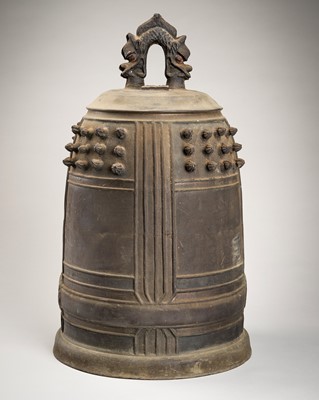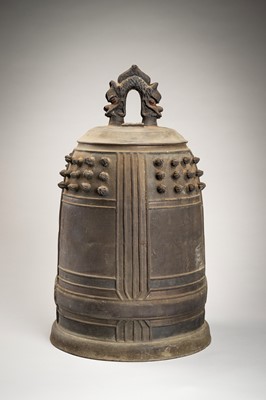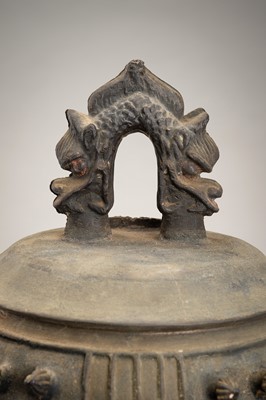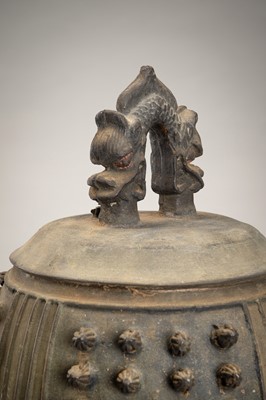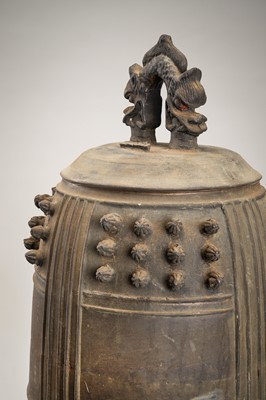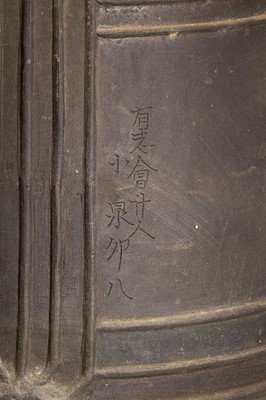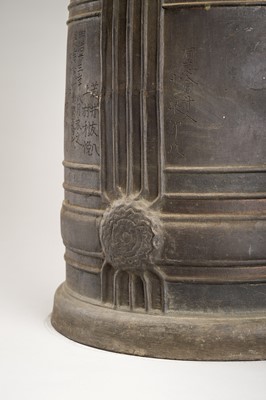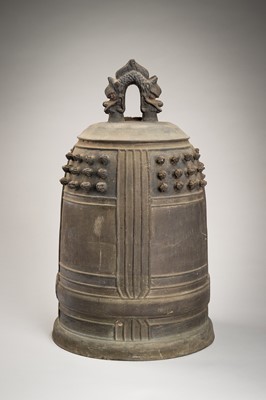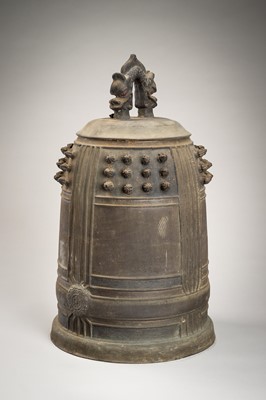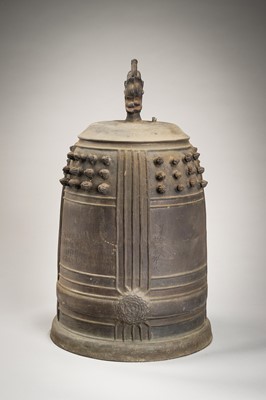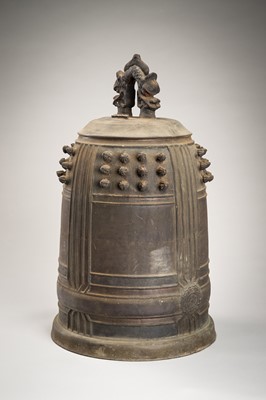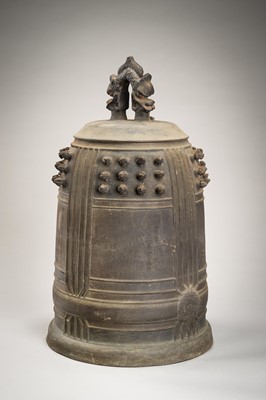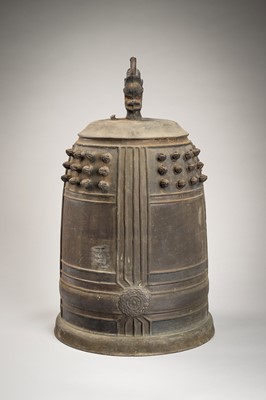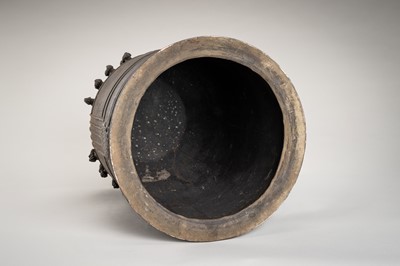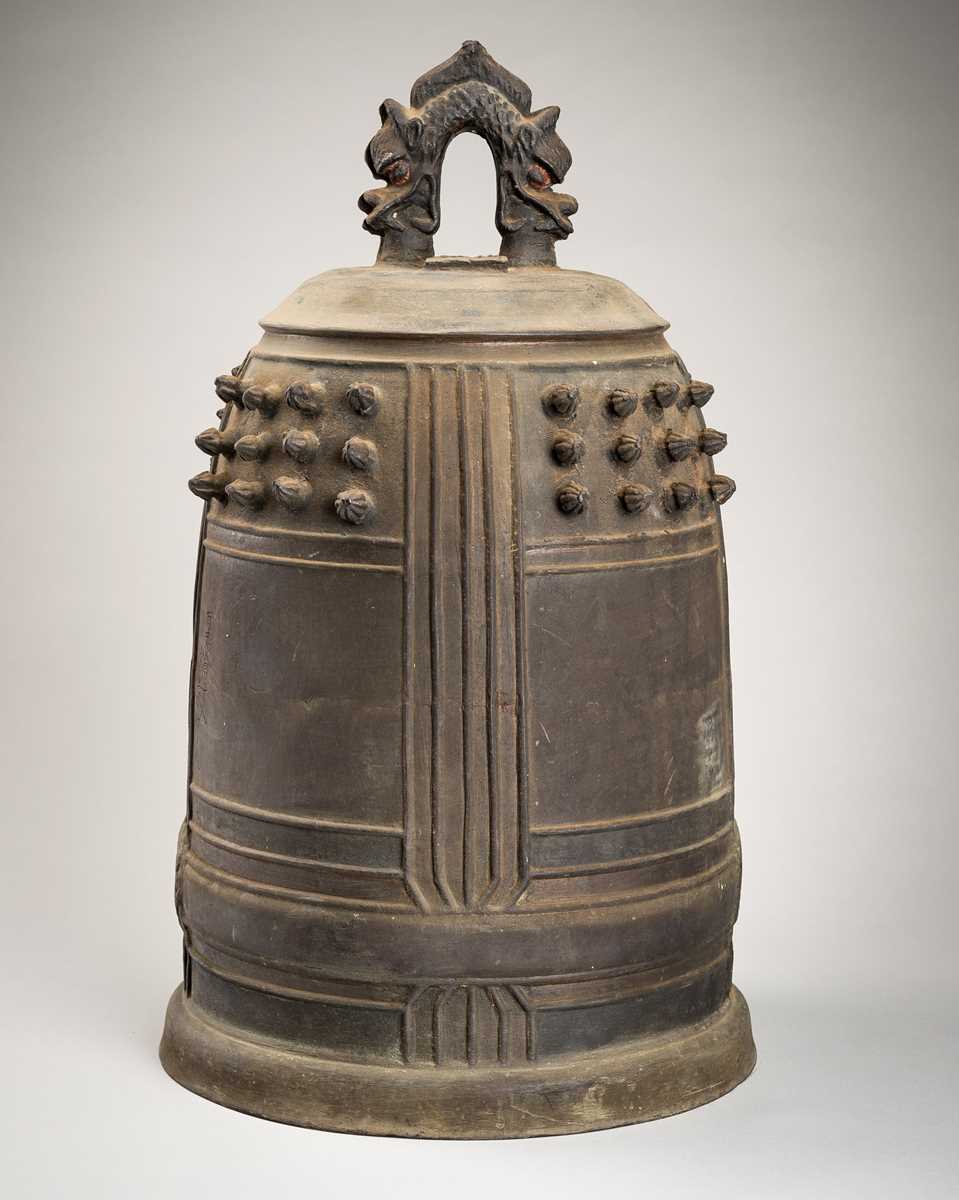17th Jan, 2024 11:00
Asian Art Discoveries
203
A LARGE BRONZE BONSHO BELL FOR THE ENMEI-IN TEMPLE, DATED 1900
Sold for €2,080
including Buyer's Premium
Japan, Yokohama, dated 1900
Well cast in barrel form, decorated in high relief with horizontal and vertical lines, bands of bosses, and flowerheads, surmounted by a twin dragon loop handle. The side engraved with an inscription dating the bell to the 33rd year of the Meiji period (corresponding to 1900), naming the devotees who commissioned the bell, and identifying the temple for which it was made.
Condition: Very good condition with wear, casting flaws, signs of weathering and erosion, traces of use, and scratches.
Provenance: From a Dutch private collection.
Weight: 18.9 kg
Dimensions: Height 55.8 cm
The earliest bells date to around 600 AD, although the general design is of much earlier Chinese origin and shares some of the features seen in ancient Chinese bells. Their penetrating and pervasive tone carries over considerable distances. The sound of the bell is thought to have supernatural properties. It is believed, for example, that it can be heard in the underworld.
In Japanese ceremonies, hanging bells are used for signaling during the prayer and for calling Buddhists to worship. In China, similar bells were employed in ensembles, where they represented the yin, or "receptive" principle, and were sounded after the beat of a large drum (yang, or "creative" element). The bonsho incorporates many symbolic motifs found in the Far East. The suspension loop (ryuzo) is formed by two dragon heads and a flame; the upper third contains nipples (nyu), symbols of fertility; and the barren field below (ikenomachi) provides a place for poetry or iconography. The chrysanthemum, a symbol of longevity and happiness, forms the striking surface (shuza). The bonsho may occasionally be heard in the kabuki theatre's off-stage ensembles.
The Enmei-in Temple in Yokohama was rebuilt during the 19th century, but local legend dates the foundations of the temple to the 9th century. According to oral tradition, the temple was originally built by Kobo Daishi, possibly falling into its dilapidated state during the Edo period. Today it houses a large statue of Buddha dedicated by the Tokugawa family, Fudomyouo. The temple is known for the story of the priest Nitto, who is executed for murder and sexual promiscuity.
Japan, Yokohama, dated 1900
Well cast in barrel form, decorated in high relief with horizontal and vertical lines, bands of bosses, and flowerheads, surmounted by a twin dragon loop handle. The side engraved with an inscription dating the bell to the 33rd year of the Meiji period (corresponding to 1900), naming the devotees who commissioned the bell, and identifying the temple for which it was made.
Condition: Very good condition with wear, casting flaws, signs of weathering and erosion, traces of use, and scratches.
Provenance: From a Dutch private collection.
Weight: 18.9 kg
Dimensions: Height 55.8 cm
The earliest bells date to around 600 AD, although the general design is of much earlier Chinese origin and shares some of the features seen in ancient Chinese bells. Their penetrating and pervasive tone carries over considerable distances. The sound of the bell is thought to have supernatural properties. It is believed, for example, that it can be heard in the underworld.
In Japanese ceremonies, hanging bells are used for signaling during the prayer and for calling Buddhists to worship. In China, similar bells were employed in ensembles, where they represented the yin, or "receptive" principle, and were sounded after the beat of a large drum (yang, or "creative" element). The bonsho incorporates many symbolic motifs found in the Far East. The suspension loop (ryuzo) is formed by two dragon heads and a flame; the upper third contains nipples (nyu), symbols of fertility; and the barren field below (ikenomachi) provides a place for poetry or iconography. The chrysanthemum, a symbol of longevity and happiness, forms the striking surface (shuza). The bonsho may occasionally be heard in the kabuki theatre's off-stage ensembles.
The Enmei-in Temple in Yokohama was rebuilt during the 19th century, but local legend dates the foundations of the temple to the 9th century. According to oral tradition, the temple was originally built by Kobo Daishi, possibly falling into its dilapidated state during the Edo period. Today it houses a large statue of Buddha dedicated by the Tokugawa family, Fudomyouo. The temple is known for the story of the priest Nitto, who is executed for murder and sexual promiscuity.
Zacke Live Online Bidding
Our online bidding platform makes it easier than ever to bid in our auctions! When you bid through our website, you can take advantage of our premium buyer's terms without incurring any additional online bidding surcharges.
To bid live online, you'll need to create an online account. Once your account is created and your identity is verified, you can register to bid in an auction up to 12 hours before the auction begins.
Intended Spend and Bid Limits
When you register to bid in an online auction, you will need to share your intended maximum spending budget for the auction. We will then review your intended spend and set a bid limit for you. Once you have pre-registered for a live online auction, you can see your intended spend and bid limit by going to 'Account Settings' and clicking on 'Live Bidding Registrations'.
Your bid limit will be the maximum amount you can bid during the auction. Your bid limit is for the hammer price and is not affected by the buyer’s premium and VAT. For example, if you have a bid limit of €1,000 and place two winning bids for €300 and €200, then you will only be able to bid €500 for the rest of the auction. If you try to place a bid that is higher than €500, you will not be able to do so.
Online Absentee and Telephone Bids
You can now leave absentee and telephone bids on our website!
Absentee Bidding
Once you've created an account and your identity is verified, you can leave your absentee bid directly on the lot page. We will contact you when your bids have been confirmed.
Telephone Bidding
Once you've created an account and your identity is verified, you can leave telephone bids online. We will contact you when your bids have been confirmed.
Classic Absentee and Telephone Bidding Form
You can still submit absentee and telephone bids by email or fax if you prefer. Simply fill out the Absentee Bidding/Telephone bidding form and return it to us by email at office@zacke.at or by fax at +43 (1) 532 04 52 20. You can download the PDF from our Upcoming Auctions page.
How-To Guides
How to Create Your Personal Zacke Account
How to Register to Bid on Zacke Live
How to Leave Absentee Bids Online
How to Leave Telephone Bids Online
中文版本的操作指南
创建新账号
注册Zacke Live在线直播竞拍(免平台费)
缺席投标和电话投标
Third-Party Bidding
We partner with best-in-class third-party partners to make it easy for you to bid online in the channel of your choice. Please note that if you bid with one of our third-party online partners, then there will be a live bidding surcharge on top of your final purchase price. You can find all of our fees here. Here's a full list of our third-party partners:
- 51 Bid Live
- EpaiLive
- ArtFoxLive
- Invaluable
- LiveAuctioneers
- the-saleroom
- lot-tissimo
- Drouot
Please note that we place different auctions on different platforms. For example, in general, we only place Chinese art auctions on 51 Bid Live.
Bidding in Person
You must register to bid in person and will be assigned a paddle at the auction. Please contact us at office@zacke.at or +43 (1) 532 04 52 for the latest local health and safety guidelines.
